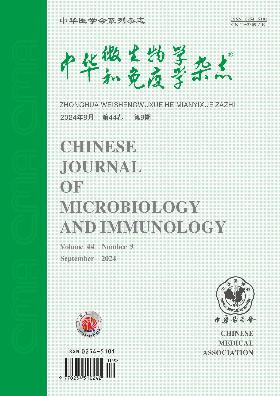Effects of Mycobacterium tuberculosis liposaccharide ManLAM on CE protein-induced B cell activation
Q4 Immunology and Microbiology
引用次数: 0
Abstract
Objective To investigate the influence and potential mechanism of mannose-capped lipoarabinomannan (ManLAM) to B cells responding to Mycobacterium tuberculosis (Mtb) infection. Methods B cells were separated from patients with active pulmonary tuberculosis using magnetic beads and then stimulated with ManLAM in combination with CE protein. Flow cytometry was performed to evaluate the apoptosis, proliferation and activation of B cells. The secretion of cytokines and CE protein-specific IgG subclasses were detected by ELISA. ELISPOT assay was used to analyze the influence on the differentiation of B cells into CE protein-specific antibody-secreting cells (ASCs). Results ManLAM inhibited the CE protein-induced proliferation and activation of B cells and the production of pro-inflammatory cytokines, resulting in significantly increased secretion of the immunosuppressive cytokine IL-10. It also inhibited the differentiation of B cells into CE protein-specific IgG secretory cells, but had no significant influence on the differentiation to IgM secretory cells. Moreover, ManLAM inhibited the secretion of CE protein-specific IgG1 and IgG3 and induced the secretion of immunosuppressive IgG4 via TLR2. Conclusions This study suggested that ManLAM could inhibit the anti-tuberculosis immune response of B cells, which provided new theoretical reference for better understanding the immune escape mechanism in Mtb infection. Key words: Mannose-capped lipoarabinomannan (ManLAM); B cell; TLR2; IgG subclasses结核分枝杆菌多糖ManLAM对CE蛋白诱导的B细胞活化的影响
目的探讨甘露糖封端的阿拉伯脂肪瘤聚糖(ManLAM)对结核分枝杆菌(Mtb)感染B细胞反应的影响及其潜在机制。方法用磁珠从活动性肺结核患者中分离B细胞,然后用ManLAM联合CE蛋白刺激。流式细胞仪检测B细胞的凋亡、增殖和活化。ELISA检测细胞因子和CE蛋白特异性IgG亚类的分泌。采用ELISPOT法分析对B细胞分化为CE蛋白特异性抗体分泌细胞(ASCs)的影响。结果ManLAM抑制了CE蛋白诱导的B细胞增殖和活化以及促炎细胞因子的产生,导致免疫抑制细胞因子IL-10的分泌显著增加。它还抑制B细胞分化为CE蛋白特异性IgG分泌细胞,但对分化为IgM分泌细胞没有显著影响。此外,ManLAM通过TLR2抑制CE蛋白特异性IgG1和IgG3的分泌,并诱导免疫抑制性IgG4的分泌。结论ManLAM可抑制B细胞的抗结核免疫反应,为进一步了解结核分枝杆菌感染的免疫逃逸机制提供了新的理论参考。关键词:甘露糖封端的阿拉伯脂质体聚糖(ManLAM);B细胞;TLR2;IgG亚类
本文章由计算机程序翻译,如有差异,请以英文原文为准。
求助全文
约1分钟内获得全文
求助全文
来源期刊

中华微生物学和免疫学杂志
Immunology and Microbiology-Virology
CiteScore
0.50
自引率
0.00%
发文量
6906
期刊介绍:
Chinese Journal of Microbiology and Immunology established in 1981. It is one of the series of journal sponsored by Chinese Medical Association. The aim of this journal is to spread and exchange the scientific achievements and practical experience in order to promote the development of medical microbiology and immunology. Its main contents comprise academic thesis, brief reports, reviews, summaries, news of meetings, book reviews and trends of home and abroad in this field. The distinguishing feature of the journal is to give the priority to the reports on the research of basic theory, and take account of the reports on clinical and practical skills.
 求助内容:
求助内容: 应助结果提醒方式:
应助结果提醒方式:


